New Story Explores Braille’s Role and Use in Accessible Technology and the Digital Age
In some ways Braille was one of the original accessible technologies, one that opened up a universe of books and reading material to blind readers. The explosion of modern technology, though, is changing how Braille is used. A new story by NPR explores these changes in an interview with Judy Dixon, Consumer Relations Officer at the Library of Congress’ National Library Service for the Blind and Physically Handicapped.
Almost 200 years later, Braille hasn’t changed so much. But with the advent of computer screens, tablets, smartphones and e-readers, the way we read things has. Judy Dixon…speaks with NPR’s Audie Cornish about the ways technology has changed Braille reading over the past few decades.
The major drawback of refreshable Braille devices is that they are expensive. These devices are in the thousands [of dollars]. So a smaller version like this 14-cell unit that I have here would be about $1,500. Larger units, a 40-cell, would be in the neighborhood of [$3,000] to $4,000, and the prices go up. So these prices are somewhat prohibitive for many people.
— Judy Dixon. “For The Blind, Connected Devices Create A Novel Way To Read.” NPR. 1/3/14.
Learn about refreshable Braille devices, how smart phones and e-readers can work with Braille, and the future of that writing system in this interview.








